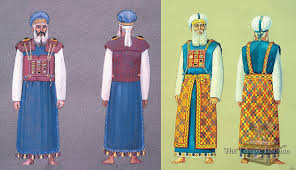Make the Robe of the Ephod
28:31-35 and 39:22-26
Make a robe of the Ephod DIG: What did this second piece of clothing look like? How does this relate to Yeshua? What do clothes and bells have to do with being near to God?
REFLECT: Believers are to clothe themselves with the new self . . . that expresses itself in true righteousness and holiness that flow from truthfulness (Ephesians 4:24-25). How can you dress in this spiritual attire?

Dressing the high priest properly was critical for approaching God. A sleeveless robe that went down to the ankles was worn over the undergarments as his second piece of clothing. It was woven of blue cloth, with an opening for the head in its center and embodied the color of the heavens. No other colored material was to be mixed with it. Around the head opening there was a woven edge like a collar so that it would not tear (28:31-32, 39:22-23). It was held in place by the skillfully woven waistband that was of one piece with the ephod (28:8).
The robe was a symbol of Messiah’s position, office and character, as our perfect High Priest (see the commentary on Hebrews, to see link click Bl – Yeshua the Melchizedek Priest). It speaks to us of His robe of righteousness, which is given to all who accept His free gift of righteousness by faith in His shed blood. The prophet Isaiah spoke of this when he said: I delight greatly in ADONAI, my soul rejoices in my God. For He has clothed me with garments of salvation and arrayed me in a robe of righteousness, as a bride-groom adorns his head like a priest, and as a bride adorns herself with her jewels (Isaiah 61:10). And Rabbi Sha’ul added: This righteousness from God comes through faith in Jesus Christ (Romans 3:22). This gift is available to anyone who will accept it, because it comes through faith in Christ. It is as though a robe were on display in a store window. It is available to all. But only the one who takes it and wears it is clothed by it. Jesus Christ paid the price of the robe that he offers to all. It is only for us to receive it as His gift of grace. Could anything be more wonderful? More simple? Even a little child could understand it.620
Around the hem of the seamless robe, Bezalel placed imitation pomegranates made of blue, purple and scarlet yarn and finely twisted linen, with gold bells interspaced between them. The gold bells and the pomegranates were to alternate all the way around the hem of the robe (28:33-34, 39:24-25). ADONAI commanded that Aaron, or any subsequent high priest, must wear the robe when they ministered in the Sanctuary. Hiram of Tyre used the pomegranate as a decoration in his construction of Solomon’s temple (First Kings 7:18-20). Pomegranates were abundant in ancient Palestine, and were among the fruits that the spies brought back to Moses when they went into the Land before their forty years of wilderness wanderings (Numbers 13:23). Therefore, the purpose of the pomegranates, aside from weighing down the robe so it would not fly up and expose the high priest in the wind, was perhaps to symbolize the fruitfulness of the Land of promise.621
The sound of the bells would assure the people of God’s mercy in allowing the high priest to minister on their behalf, and also announced his coming before ADONAI. He was, after all, coming before the presence of the King. Only a high priest properly dressed could enter the Most Holy Place and minister before ADONAI (28:35, 39:26). Disregarding those instructions would result in his death. But the movement of the bells would tell people that he was still living, because if his offering were not acceptable, the sound of the bells would stop. The rabbis teach that a rope would be tied around the ankle of the high priest on the Day of Atonement, and if he died in the Most Holy Place they could pull him out since no one else could enter in. However, the sound of the bells as the priest left the Sanctuary called for great rejoicing for the atonement that had been completed.622
We ought to be struck by the specific nature of God’s commands to Isra’el regarding how members of the priesthood were to dress and to act. The regulations, at times, seem to go on forever. But the quantity of detail underscores the fact that the priesthood was to operate according to heavenly specifications. It would run in no other way. Aaron’s sons were killed because they offered strange fire before ADONAI (Leviticus 10:1-7 CJB). Their good intentions were insufficient. Uzziah apparently meant well when he reached out and took hold of the Ark of the Covenant so it would not fall (Second Samuel 6:1-8). He should have obeyed God’s Word (Numbers 1:51, 4:15, 19-20). As believers, the end never justifies the means. We are to act according to Scripture. The Bible alone is the rule of our obedience. Thus, we must have a familiarly with it. Knowledge of Scripture is essential to obedience.623



Leave A Comment